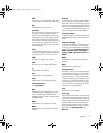
Glossary 3
that allows the microprocessor to com-
municate with controllers for all the
various peripheral devices connected to
the computer. Your computer also con-
tains an address bus and a data bus for
communications between the micro-
processor and RAM.
E\WH
Eight contiguous bits of information, the
basic data unit used by your computer.
%=7
Abbreviation for
Bundesamt fur Zulassun-
gen in der Telekommunikation
.
&
Abbreviation for Celsius.
FDFKH
To facilitate quicker data retrieval, a stor-
age area for keeping a copy of data or
instructions. For example, your comput-
ers BIOS may cache ROM code in faster
RAM. Or, a disk-cache utility may reserve
RAM in which to store frequently access-
ed information from your computers disk
drives; when a program makes a request
to a disk drive for data that is in the cache,
the disk-cache utility can retrieve the data
from RAM faster than from the disk drive.
FDUGHGJHFRQQHFWRU
On the bottom of an expansion card, the
metal-contact section that plugs into an
expansion-card connector.
&&)7
Abbreviation for cold cathode fluorescent
tube.
&'520
Abbreviation for compact disc read-only
memory. CD-ROM drives use optical
technology to read data from compact
discs. Compact discs are read-only stor-
age devices; you cannot write new data
to a compact disc with standard CD-ROM
drives.
&*$
Abbreviation for color graphics adapter.
FP
Abbreviation for centimeter(s).
&026
Acronym for complementary metal-oxide
semiconductor. In computers, CMOS
memory chips are often used for NVRAM
storage.
&20Q
The MS-DOS device names for the first
through fourth serial ports on your com-
puter are COM1, COM2, COM3, and
COM4. MS-DOS supports up to four serial
ports. However, the default interrupt for
COM1 and COM3 is IRQ4, and the default
interrupt for COM2 and COM4 is IRQ3.
Therefore, you must be careful when con-
figuring software that runs a serial device
so that you dont create an interrupt
conflict.
&21
The MS-DOS device name for the con-
sole, which includes your computers
keyboard and text displayed on the
screen.
FRQILJV\VILOH
When you boot your computer, MS-DOS
runs any commands contained in the text
file, config.sys (before running any com-
mands in the autoexec.bat file). A
config.sys file is not required to boot
MS-DOS, but provides a convenient place
to run commands that are essential for
setting up a consistent computing environ-
mentsuch as loading device drivers with
a device= statement.
FRQWUROOHU
A chip or expansion card that controls the
transfer of data between the micro-
processor and a peripheral, such as a disk
drive or the keyboard.
FRQYHQWLRQDOPHPRU\
The first 640 KB of RAM. Unless they are
specially designed, MS-DOS programs
are limited to running in conventional
memory. See also EMM, expanded mem-
ory, extended memory, HMA, memory
manager, upper memory area, and XMM.
FRSURFHVVRU
A coprocessor relieves the computers
microprocessor of specific processing
tasks. A math coprocessor, for example,
3502Ebk0.book Page 3 Friday, November 13, 1998 10:00 AM


















